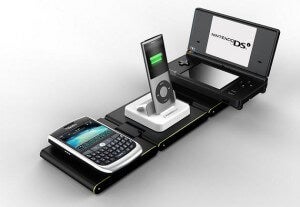
If you want a real-life example of a mad scientist, you could do a lot worse than Nicola Tesla. His incredible genius was so far ahead of his time, and often so poorly expressed, that he died an ostracized pauper. Still, many of Tesla’s electromagnetic innovations (such as alternating current) live on today and there’s one that could find a renaissance in the next few years: wireless electricity. To horrifically simplify the concept: there’s no need for long wires to conduct electricity, we can broadcast electromagnetic waves through the air and harness the electricity using a loop of wire as a receiver. MIT researchers formed WiTricity to promote that very technology. Now, companies focused on a special application of wireless electricity have broken into the retail market with force. Powermat, and soon WiPower, provide “wireless charging” stations for home electronics. Instead of plugging in your mobile phone or handheld video game, you just strap a receiver on it, and place it on a charging mat. This “drop and charge” innovation is set to make a big impact in retail sales (Powermat has already sold more than 750,000 products in just under two months) and could be the first step to the wireless electricity revolution that changes the way we power our lives. Check out a demo from Powermat and a CES interview with WiPower after the break.
The WiPower booth was pretty cool. The floating lights you’ll see were a nice touch and actually a callback to Tesla (he did a similar unconnected light bulb demo more than 100 years ago).
At the moment, Powermat is at the head of the wireless charging game. It’s sold 750,000 units over this past winter season and is looking to aggressively expand in 2010. It’s also received media coverage everywhere from Ellen DeGeneres to Mike & Mike on ESPN. The Powermat pads (transmitters) range in price from $40 to $140+ (depending on size, portability,etc) and receivers are around $30 for Blackberries, and $40 for iPhones. Other receiver types vary around the same price range.
WiPower, however, will come to market this year (second quarter) and offers a few innovations. For roughly the same pricing (perhaps $10-20 less in some cases) the WiPower products will eventually come in packages that embed into desks, and allow you to charge anywhere on the mat – no magnetic locking and a higher limit on the number of devices. So a little more flexibility perhaps, and maybe a little cheaper.
But I’m not really concerned whether Powermat or WiPower (or some other developer) wins the wireless charging market. The implications of this technology are far larger. Right now the receivers won’t charge a product from more than an inch away. The coupling between transmitter and receiver just isn’t good enough to work over longer distances. But as Eric Giler mentioned at TED, conceivably we could do a lot better than that. We could use a similar method of coupling to power objects from a meter away or farther. At that distance, we could power electric cars while they were still on the road, or create homes without plugs.
WiPower, I should mention, is actively pursuing development outside of the table top charging arena. They’ve partnered with Mantaro, EMS, and others to find new ways of adapting the technology to different environments. While at CES, I talked with a Mantaro rep who thought that hermetically sealed charging stations could have big impacts on deep sea and space exploration. Maybe so. Certainly it’s good to see WiPower looking to expand into new areas. If you’re a developer, you can even purchase a kit (~$4500) to get you started in adapting the technology to a new problem.
I’m very hopeful that these wireless charging stations are just the first step in many towards freely broadcast electrical power. That was, at the core, part of Tesla’s dream for the future and I think it’s still an admirable one for today. It will take many levels of innovation, and there are many engineering problems to solve (safety, coupling efficiency, etc), but one day we may have to explain to our grandchildren that in our day you used to have to plug devices into the wall to get them to work. Barbaric, but true.
[photo credit: Powermat]



